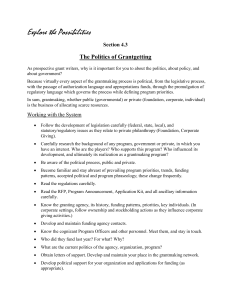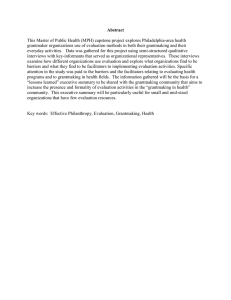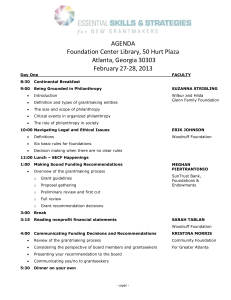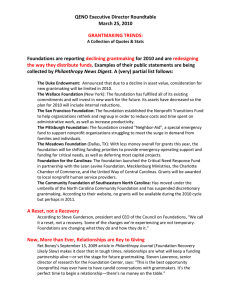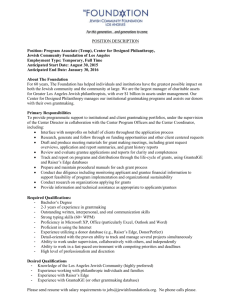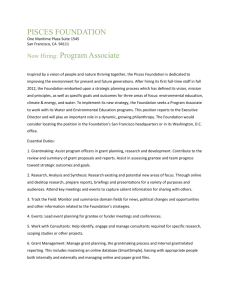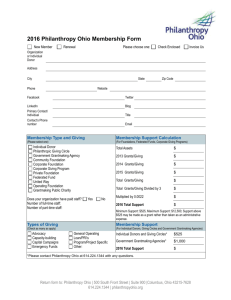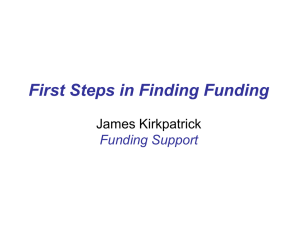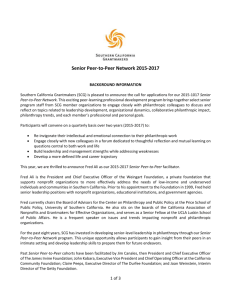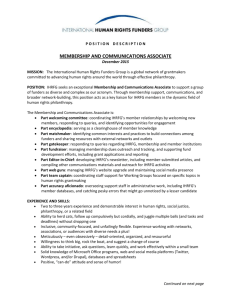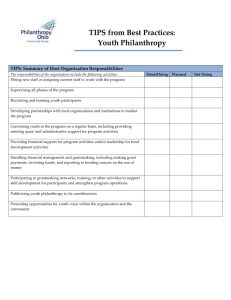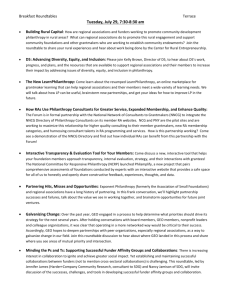About_Ed_Philanthropy
advertisement
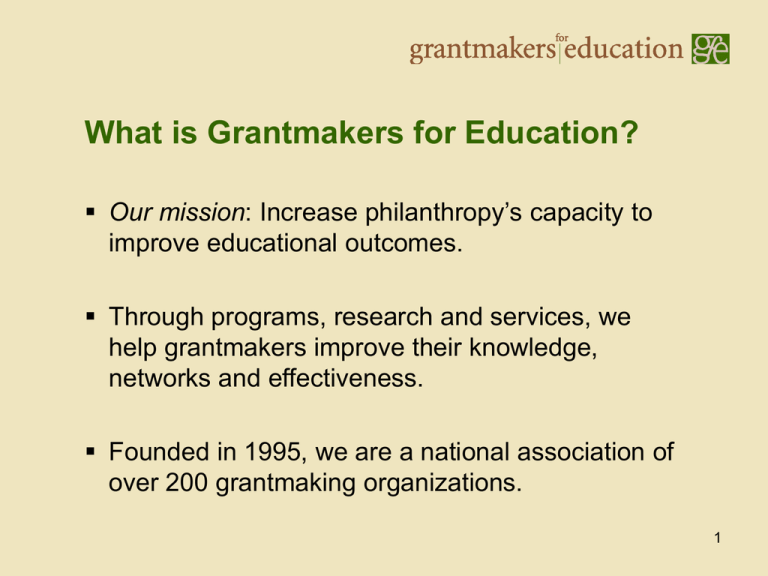
What is Grantmakers for Education? Our mission: Increase philanthropy’s capacity to improve educational outcomes. Through programs, research and services, we help grantmakers improve their knowledge, networks and effectiveness. Founded in 1995, we are a national association of over 200 grantmaking organizations. 1 GFE is the largest and most diverse network of foundations and donors working to improve educational outcomes … from small to large foundations … from early education through higher education issues. 2 Key Activities: Annual conference (fall) Issue-specific briefings (throughout year) Funder communities of practice Information-sharing (which funders are working on which issues?) Case studies describing effective education grantmaking Online knowledge center to find experts and resources Newsletters, essays and research digests 3 Board of Directors: Ivye Allen, Trustee Winthrop Rockefeller Foundation (Arkansas) Stephen Patrick, Director – Youth & Emerging Initiatives New Mexico Community Foundation Stephen Barkanic, Program Director Howard Hughes Medical Institute (Maryland) Lata Reddy, Vice President The Prudential Foundation (New Jersey) Lori Bezahler, President The Edward W. Hazen Foundation (New York) Ramon Rodriguez, Southeast Fund Giving Manager Washington Mutual (Georgia) Barbara Chow, Executive Director National Geographic Education Foundation (Washington, DC) Jay Sherwin, Senior Program Officer Nellie Mae Education Foundation (Massachusetts) Susan Conner, Executive Vice President Lumina Foundation For Education (Indiana) Carol Edwards, Director of Programs The NEA Foundation For The Improvement Of Education (Washington, DC) Lynn Walker Huntley, President Southern Education Foundation, Inc. (Georgia) Bruno Manno, Senior Associate for Education The Annie E. Casey Foundation (Maryland) Ruby Takanishi, President Foundation For Child Development (New York) Sandra Treacy, Executive Director W. Clement And Jessie V. Stone Foundation (California) Thomas Vander Ark, Executive Director - Education Bill & Melinda Gates Foundation (Washington) Susan Wally, consultant Greater Kansas City Community Foundation (Missouri) Robin Willner, Director – Corporate Community Relations 4 IBM Corporation (New York) In education, what does philanthropy bring to the table? Assets Not an organized “system” – so different (competing) ideas, approaches and innovations are pursued simultaneously Independence – to take risks and take the long view Money – discretionary plus other resources (expertise, convening) Liabilities Not an organized “system” – so everyone does their own thing with little coordination Independence – not doing the actual work; no market pressure Money – resources are small compared to the problems and to the amount of public investment 5 How does philanthropy cause change? Cash: sustain what works, bet on the new, evaluate, take to scale. Conceptualization: analyze/fact-find, focus attention Catalyst: convene, initiate new efforts, serve as non-partisan point of view Critical voice: “seal of approval,” gadfly, advocate 6 What are trends in our field? Collaboration between funders to achieve greater leverage on a specific project or issue. Accountability/pressure on foundations to deliver results from their grantmaking investments: Are we effective? Are we making a difference? Renewed focus on changing public policy – and greater use of strategic communications, advocacy campaigns and grassroots organizing to affect policy change. 7 What are trends in our field? Interest in “capacity building” to improve management and impact of both school systems and nonprofits. More “focus” on limiting grantmaking to a specific education idea or strategy. Support for education “entrepreneurs” who bring a new outlook, new energy and new ideas to education reform (charter management organizations, alternative certification efforts for principals and teachers, etc.) 8 What are trends in our field? Bottom line: Foundations often define themselves by how well they are solving social issues. Thus, all these suggested trends may in fact be part of the same trend: Funders today say they most want the greatest leverage to achieve the greatest impact. 9 What issues and strategies are attracting attention? Teaching quality: pipeline, professional development Charter schools: choice vs. new schools/options School system capacity Replication/scale Policy advocacy: grasstops, grassroots 10 Is education philanthropy making a difference? Yes – foundation grants have: Underwritten classrooms tools, teacher fellowships and scholarships that have offered hundreds of thousands of individual children better opportunities. Helped create thousands of excellent schools. Advanced efforts in urban school districts to improve management and performance. Fueled efforts to implement new public policies. Created and sustained fresh nonprofits working to develop new solutions. Identified innovative and effective strategies through 11 foundation-funded research. Examples of how philanthropy has made an impact in education: Research: Consortium on Chicago School Research, MDRC, reading instruction and methods Schools and networks: Coalition for Essential Schools, KIPP, High Tech High, public education funds School districts: San Diego, Chattanooga, Boston Systemic innovations: Teach for America, National Board Certification, Just for the Kids, Broad institutes Advocacy: Achieve, Heritage Foundation, EdTrust Policy: Universal pre-kindergarten, school finance lawsuits, voucher lawsuits, charter school movement, standards-based education/NCLB 12 Is education philanthropy making a difference? The answer also is “No”: Nationally, student achievement has not made dramatic gains over the past 20 years, despite philanthropic support of innovation and the best leadership in the field. The “achievement gap” still exists in most schools and systems. The challenge of scaling up excellent schools to a system of excellent schools has not been met. 13 What does GFE think makes education philanthropy most effective? Discipline and Focus Knowledge Resources Linked to Results Effective Grantees Engaged Partners Leverage, Influence and Collaboration Persistence Innovation and Constant Learning 14 Principles for Effective Education Grantmaking: #1 / Discipline and Focus In education, where public dollars dwarf private investments, a funder has greater impact when grantmaking is carefully planned and targeted. #2 / Knowledge Information, ideas and advice from diverse sources, as well as openness to criticism and feedback, can help a funder make wise choices. #3 / Resources Linked to Results Think clearly about how specific actions will lead to desired outcomes. #4 / Effective grantees A grantmaker is effective only when its grantees are effective. Especially in education, schools and systems lack capacity and grantees (both inside and outside the system) may require deeper support. 15 Principles for Effective Education Grantmaking: #5 / Engaged Partners A funder succeeds by actively engaging the individuals, institutions and communities connected with an issue to ensure “ownership” of education problems and their solutions. #6 / Leverage, Influence and Collaboration The depth and range of problems in education make it difficult to achieve meaningful change in isolation or without changing public policies. #7 / Persistence The most important problems in education are often the most complex and intractable, and will take time to solve. #8 / Innovation and Constant Learning Identifying what works – and what doesn’t – are essential to helping grantmakers and their partners achieve results. 16 720 SW Washington, Suite 605 Portland, OR 97205 503.595.2100 www.edfunders.org Barbara Chow, board chair William Porter, executive director 17
